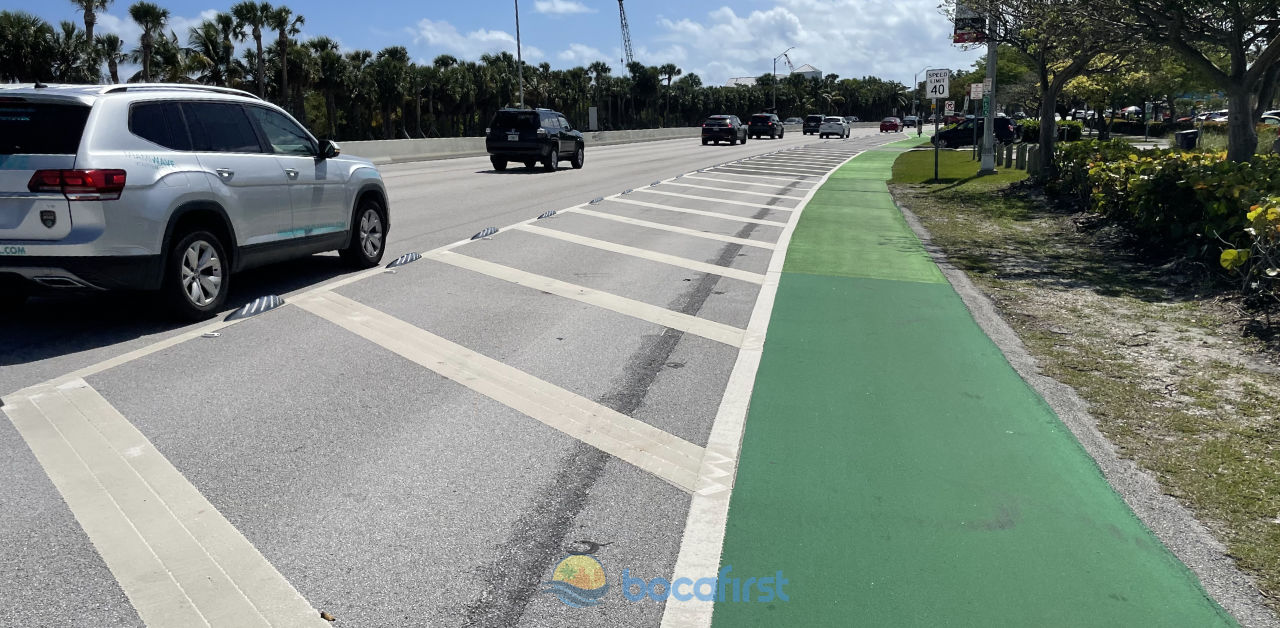Introduction
Information is provided on Florida Department of Transportation’s (FDOT) planned A1A bike lane upgrade in Boca Raton. Although we appreciate FDOT’s proposing this program, we also feel that the design is inadequate. FDOT’s planned A1A bike lane upgrade in Boca Raton is dangerous by design.
When this upgrade is completed, it will be over 20 years since A1A was last upgraded in Boca Raton so this upgrade will probably need to serve the residents for the next 20 years. We need to get it right.
While we feel that there are a number of problems with the FDOT design, this article will focus on proposed A1A bike lane changes,
Background
Reference a recent article for information on Complete Streets and Vision Zero. Also included in this linked article is FDOT’s plan for that A1A upgrade. Planned A1A Upgrade in Boca Raton Needs an Upgrade – BocaFirst
Problem – Dangerous by Design
These are the bicyclist requirements for Complete Streets.
- Quality bicycle facilities include spaces comfortably shared with traffic, clearly marked bike lanes (or appropriate separation based on speed and volume of vehicle traffic), adequate bicycle parking, intersection treatments, and destinations accessible by bike.
- Unlike traditional roadway planning where users are assumed to follow the rules, Vision Zero assumes roadway users will make mistakes.
- Human error is inevitable, so the transportation system should allow for it to happen without death or serious injury
The FDOT A1A upgrade plan calls for five- and six-foot bike lanes which do not allow bike lane users to comfortably share road space with traffic. Also, a painted line delineating a bike lane from a vehicle lane offers no protection when mistakes are made. The upgrade plan is dangerous by design for both motorists and cyclists.
Suggested Solution
It is recommended that the FDOT proposed bike lanes on A1A be protected bike lanes that safely and simultaneously accommodate a wide range of users. Some of these include:
- Groups of cyclists
- Cyclists riding at all speeds
- E-bikes
- Cargo bikes
- Recumbent bikes
- Tandem bikes
- Families
- Scooters
- Skaters
Our research took us to a popular cycling venue, Key Biscayne, which has bike lanes that accommodate most of the above requirements. We suggest that the FDOT A1A design implement the Key Biscayne bike lane design. We also recommend adding a barrier feature to make these bike lanes even safer. Here is a pic of a Key Biscayne bike lane.

The smooth green bike lane is 6 feet wide and the striped area between the bike lane and the vehicle lane is 13 feet wide. The striped area allows faster cyclists to pass slower cyclists or obstacles without entering the vehicle lane. This safely and simultaneously accommodates all bike lane users without the risk of entering the vehicle lanes.
Additionally, vehicle drivers complain about being delayed by cyclist groups riding in the vehicle lanes. Our proposed solution also solves that issue.
This short (six second) video shows a fast-moving group of cyclists safely passing a slower moving cyclist (on the right with the red rear light) in the bike lane. The group doesn’t have to enter the vehicle lane as it passes the slower moving cyclist. https://youtu.be/x1Cbgp9vc_M. Video courtesy of Lucas Brunelle.
To make this bike lane even safer for A1A users we recommend installing “Armadillo” barriers as in the following pic.

Summary
This article explains why FDOT’s planned A1A bike lane upgrade in Boca Raton is Dangerous by Design. We also suggest a safe bike lane design solution from a popular cycling venue in Key Biscayne.
The mobility environment is rapidly changing and the A1A bike lanes need to be capable of accommodating these changes for the next 20 years. Now is the time to get it right.
Conclusion – Design Matters
Relatively small incremental upgrades to A1A are not acceptable as Complete Streets and Vision Zero compliant solutions. We need to think big. The article “We’ll never have safe streets if we continue to make safe choices” explains why Portland, Oregon is missing their Vision Zero goals. It is a lesson for the FDOT A1A upgrade program.

